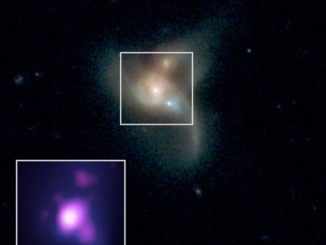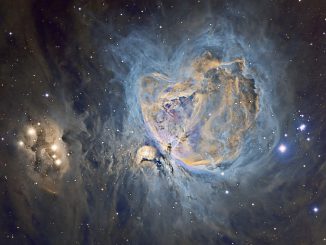
WISE




Oldest known planet-forming circumstellar disc discovered
A group of citizen scientists and professional astronomers joined forces to discover an unusual hunting ground for exoplanets. They found a red dwarf, called AWI0005x3s, surrounded by the oldest known circumstellar disc — a 45-million-year-old primordial ring of gas and dust orbiting the star from which planets can form.

X marks the spot at the centre of the Milky Way
Astronomers have uncovered the strongest evidence yet that an enormous X-shaped structure made of stars lies within the central bulge of the Milky Way. Previous computer models, observations of other galaxies, and observations of our own Galaxy have suggested that the X-shaped structure existed, but no one had observed it directly.

‘Frankenstein’ galaxy UGC 1382 surprises astronomers
About 250 million light-years away, there’s a neighbourhood of our universe that astronomers had considered quiet and unremarkable. But now, scientists have uncovered an enormous, bizarre galaxy possibly formed from the parts of other galaxies. Some 718,000 light-years across, UGC 1382 is more than seven times wider than the Milky Way.

Fastest-spinning brown-dwarf star is detected by its bursts of radio waves
Astronomers have detected what may be the most-rapidly-rotating, ultra-cool, brown-dwarf star ever seen. The super-fast rotation period of less than an hour was measured by using the 305-metre Arecibo radio telescope — the same telescope that was used to discover the first planets ever found outside our solar system.

The secret life of the Orion Nebula
Space bears witness to a constant stream of star births. Whole star clusters are often formed at the same time — and within a comparatively short period. Researchers from the Max Planck Institute for Astronomy in Heidelberg have proposed a new mechanism that relies on the interplay between magnetic fields and gravitation to explain this quick formation, investigating a filament of gas and dust which also includes the well-known Orion Nebula.

Lone planetary-mass object found in a young star family
Astronomers have found a free-floating object called WISEA 1147, thought to be an exceptionally low-mass “brown dwarf,” which is a star that lacked enough mass to burn nuclear fuel and glow like a star. Reasearchers using data from NASA’s WISE and 2MASS sky surveys found the object in TW Hydrae — a young, 10-million-year-old association of stars.

Astronomers discover colossal ‘super spiral’ galaxies
A strange new kind of galactic beast has been spotted in the cosmic wilderness. Dubbed “super spirals,” these unprecedented galaxies dwarf our own spiral galaxy, the Milky Way, and compete in size and brightness with the largest galaxies in the universe. The galaxies have long hidden in plain sight by mimicking the appearance of typical spirals.
